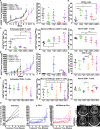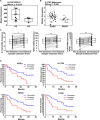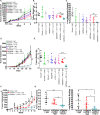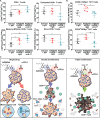Th17 cells contribute to combination MEK inhibitor and anti-PD-L1 therapy resistance in KRAS/p53 mutant lung cancers
- PMID: 33972557
- PMCID: PMC8110980
- DOI: 10.1038/s41467-021-22875-w
Th17 cells contribute to combination MEK inhibitor and anti-PD-L1 therapy resistance in KRAS/p53 mutant lung cancers
Abstract
Understanding resistance mechanisms to targeted therapies and immune checkpoint blockade in mutant KRAS lung cancers is critical to developing novel combination therapies and improving patient survival. Here, we show that MEK inhibition enhanced PD-L1 expression while PD-L1 blockade upregulated MAPK signaling in mutant KRAS lung tumors. Combined MEK inhibition with anti-PD-L1 synergistically reduced lung tumor growth and metastasis, but tumors eventually developed resistance to sustained combinatorial therapy. Multi-platform profiling revealed that resistant lung tumors have increased infiltration of Th17 cells, which secrete IL-17 and IL-22 cytokines to promote lung cancer cell invasiveness and MEK inhibitor resistance. Antibody depletion of IL-17A in combination with MEK inhibition and PD-L1 blockade markedly reduced therapy-resistance in vivo. Clinically, increased expression of Th17-associated genes in patients treated with PD-1 blockade predicted poorer overall survival and response in melanoma and predicated poorer response to anti-PD1 in NSCLC patients. Here we show a triple combinatorial therapeutic strategy to overcome resistance to combined MEK inhibitor and PD-L1 blockade.
Conflict of interest statement
D.L.G. declares advisory board work for Janssen, AstraZeneca, GlaxoSmithKline, and Sanofi. D.L.G. receives research grant funding from AstraZeneca, Janssen, Astellas, Ribon Therapeutics, NGM Therapeutics, and Takeda. L.A.B. declares consulting work for AstraZeneca, AbbVie, GenMab, BergenBio, Pharma Mar, SA. L.A.B. receives research grant funding from AbbVie, AstraZeneca, GenMab, Tolero Pharmaceuticals. All other authors declare that they have no competing interests.
Figures







Similar articles
-
The Combination of MEK Inhibitor With Immunomodulatory Antibodies Targeting Programmed Death 1 and Programmed Death Ligand 1 Results in Prolonged Survival in Kras/p53-Driven Lung Cancer.J Thorac Oncol. 2019 Jun;14(6):1046-1060. doi: 10.1016/j.jtho.2019.02.004. Epub 2019 Feb 13. J Thorac Oncol. 2019. PMID: 30771521 Free PMC article.
-
The HSP90 inhibitor, NVP-AUY922, sensitizes KRAS-mutant non-small cell lung cancer with intrinsic resistance to MEK inhibitor, trametinib.Cancer Lett. 2016 Mar 1;372(1):75-81. doi: 10.1016/j.canlet.2015.12.015. Epub 2015 Dec 23. Cancer Lett. 2016. PMID: 26723875
-
The superior efficacy of anti-PD-1/PD-L1 immunotherapy in KRAS-mutant non-small cell lung cancer that correlates with an inflammatory phenotype and increased immunogenicity.Cancer Lett. 2020 Feb 1;470:95-105. doi: 10.1016/j.canlet.2019.10.027. Epub 2019 Oct 20. Cancer Lett. 2020. PMID: 31644929
-
Clinical Development of BRAF plus MEK Inhibitor Combinations.Trends Cancer. 2020 Sep;6(9):797-810. doi: 10.1016/j.trecan.2020.05.009. Epub 2020 Jun 13. Trends Cancer. 2020. PMID: 32540454 Review.
-
MEK inhibitors for the treatment of non-small cell lung cancer.J Hematol Oncol. 2021 Jan 5;14(1):1. doi: 10.1186/s13045-020-01025-7. J Hematol Oncol. 2021. PMID: 33402199 Free PMC article. Review.
Cited by
-
Targeting Neutrophil Extracellular Traps: A Novel Antitumor Strategy.J Immunol Res. 2023 Nov 9;2023:5599660. doi: 10.1155/2023/5599660. eCollection 2023. J Immunol Res. 2023. PMID: 38023616 Free PMC article. Review.
-
Combination strategies with PD-1/PD-L1 blockade: current advances and future directions.Mol Cancer. 2022 Jan 21;21(1):28. doi: 10.1186/s12943-021-01489-2. Mol Cancer. 2022. PMID: 35062949 Free PMC article. Review.
-
Systematic evaluation of the predictive gene expression signatures of immune checkpoint inhibitors in metastatic melanoma.Mol Carcinog. 2023 Jan;62(1):77-89. doi: 10.1002/mc.23442. Epub 2022 Jul 4. Mol Carcinog. 2023. PMID: 35781709 Free PMC article.
-
Single-cell and bulk sequencing analyses reveal the immune suppressive role of PTPN6 in glioblastoma.Aging (Albany NY). 2023 Sep 21;15(18):9822-9841. doi: 10.18632/aging.205052. Epub 2023 Sep 21. Aging (Albany NY). 2023. PMID: 37737713 Free PMC article.
-
Immunocytes interact directly with cancer cells in the tumor microenvironment: one coin with two sides and future perspectives.Front Immunol. 2024 May 22;15:1388176. doi: 10.3389/fimmu.2024.1388176. eCollection 2024. Front Immunol. 2024. PMID: 38840908 Free PMC article. Review.
References
Publication types
MeSH terms
Substances
Grants and funding
LinkOut - more resources
Full Text Sources
Other Literature Sources
Medical
Research Materials
Miscellaneous

